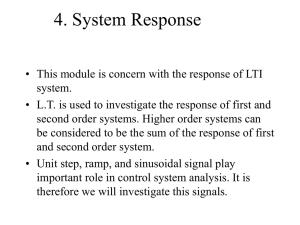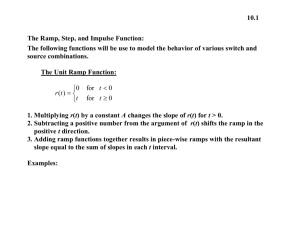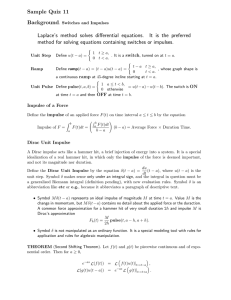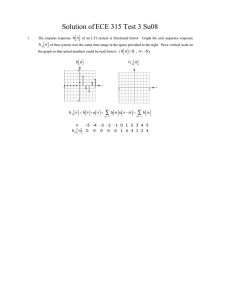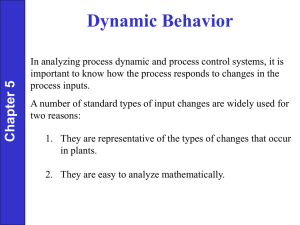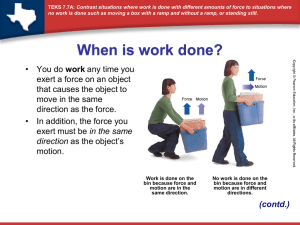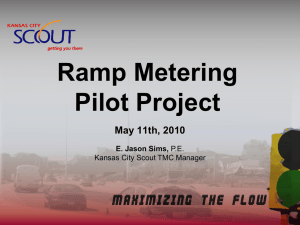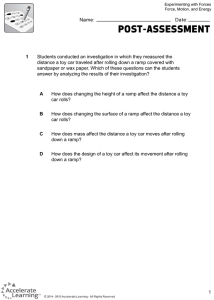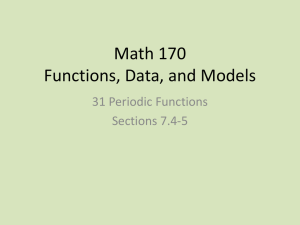Lecture-20-21: Time Domain Analysis of 1st
advertisement
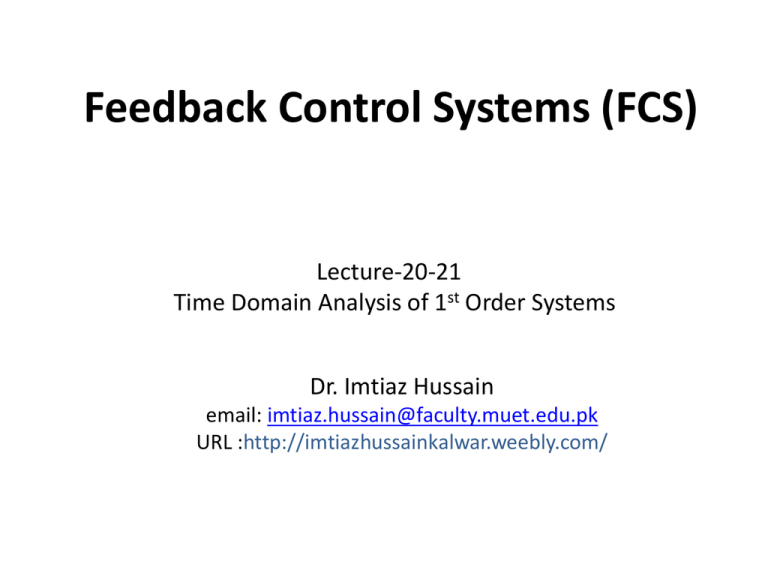
Feedback Control Systems (FCS) Lecture-20-21 Time Domain Analysis of 1st Order Systems Dr. Imtiaz Hussain email: imtiaz.hussain@faculty.muet.edu.pk URL :http://imtiazhussainkalwar.weebly.com/ Introduction • The first order system has only one pole. C(s) R( s ) K Ts 1 • Where K is the D.C gain and T is the time constant of the system. • Time constant is a measure of how quickly a 1st order system responds to a unit step input. • D.C Gain of the system is ratio between the input signal and the steady state value of output. Introduction • The first order system given below. G(s) 10 3s 1 • D.C gain is 10 and time constant is 3 seconds. • And for following system G(s) 3 s5 3/5 1 / 5s 1 • D.C Gain of the system is 3/5 and time constant is 1/5 seconds. Impulse Response of 1st Order System • Consider the following 1st order system δ(t) 1 K R(s) 0 Ts 1 t R(s) (s) 1 C(s) K Ts 1 C(s) Impulse Response of 1st Order System C(s) K Ts 1 • Re-arrange following equation as C(s) K /T s 1/T • In order represent the response of the system in time domain we need to compute inverse Laplace transform of the above equation. 1 at L Ce sa C c(t ) K T e t / T Impulse Response of 1st Order System K • If K=3 and T=2s then c ( t ) e t / T T K/T*exp(-t/T) 1.5 c(t) 1 0.5 0 0 2 4 6 Time 8 10 Step Response of 1st Order System • Consider the following 1st order system R(s) K C(s) Ts 1 R( s ) U ( s ) 1 s C(s) K s Ts 1 • In order to find out the inverse Laplace of the above equation, we need to break it into partial fraction expansion Forced Response C(s) K s KT Ts 1 Natural Response Step Response of 1st Order System T 1 C(s) K s Ts 1 • Taking Inverse Laplace of above equation c(t ) K u (t ) e • Where u(t)=1 c(t ) K 1 e t / T t / T • When t=T c(t ) K 1 e 1 0 . 632 K t / T K*(1-exp(-t/T)) 11 10 Step Response 9 8 D .C Gain K 7 c(t) • Step Response of 1st Order System c ( t ) K 1 e If K=10 and T=1.5s then steady state output Input 63 % 6 10 1 5 4 3 2 Unit Step Input 1 0 0 1 2 3 4 5 Time 6 7 8 9 10 t / T K*(1-exp(-t/T)) 11 10 T=1s 9 8 T=3s 7 c(t) • Step Response of 1st Order System c ( t ) K 1 e If K=10 and T=1, 3, 5, 7 T=5s 6 T=7s 5 4 3 2 1 0 0 5 10 Time 15 Step Response of 1st order System • System takes five time constants to reach its final value. t / T K*(1-exp(-t/T)) 11 10 K=10 9 8 7 c(t) • Step Response of 1st Order System c ( t ) K 1 e If K=1, 3, 5, 10 and T=1 6 K=5 5 4 K=3 3 2 K=1 1 0 0 5 10 Time 15 Relation Between Step and impulse response • The step response of the first order system is c(t ) K 1 e t / T K Ke t / T • Differentiating c(t) with respect to t yields dc ( t ) dt d dt dc ( t ) dt K Ke K T e t / T t / T Example#1 • Impulse response of a 1st order system is given below. c ( t ) 3e • Find out – – – – Time constant T D.C Gain K Transfer Function Step Response 0 .5 t Example#1 • The Laplace Transform of Impulse response of a system is actually the transfer function of the system. • Therefore taking Laplace Transform of the impulse response given by following equation. c ( t ) 3e C(s) 3 1 S 0 .5 C(s) (s) 0 .5 t C(s) R( s ) C(s) R( s ) 3 S 0 .5 (s) 3 S 0 .5 6 2S 1 Example#1 • Impulse response of a 1st order system is given below. c ( t ) 3e 0 .5 t • Find out – – – – – Time constant T=2 D.C Gain K=6 Transfer Function C ( s ) 6 R( s ) 2S 1 Step Response Also Draw the Step response on your notebook Example#1 • For step response integrate impulse response c ( t ) 3e 0 .5 t c ( t )dt 3 e c s (t ) 6e 0 .5 t 0 .5 t dt C • We can find out C if initial condition is known e.g. cs(0)=0 0 .5 0 0 6e C 6 C c s (t ) 6 6e 0 .5 t Example#1 • If initial Conditions are not known then partial fraction expansion is a better choice C(s) R( s ) 6 2S 1 since R ( s ) is a step input , R ( s ) 1 s C(s) 6 s 2 S 1 6 s 2 S 1 6 s 2 S 1 A s 6 s B 2s 1 6 s 0 .5 c( t ) 6 6e 0 .5 t Partial Fraction Expansion in Matlab • If you want to expand a polynomial into partial fractions use residue command. y( s ) x( s ) r1 s p1 Y=[y1 y2 .... yn]; X=[x1 x2 .... xn]; [r p k]=residue(Y, X) r2 s p2 rn s pn k Partial Fraction Expansion in Matlab • If we want to expand following polynomial into partial fractions 4s 8 Y=[-4 8]; X=[1 6 8]; [r p k]=residue(Y, X) r =[-12 p =[-4 k = [] 8] -2] s 2 6s 8 4 s 8 2 s 6s 8 4s 8 s 2 6s 8 r1 s p1 12 s4 r2 s p2 8 s2 Partial Fraction Expansion in Matlab • If you want to expand a polynomial into partial fractions use residue command. C(s) Y=6; X=[2 1 0]; [r p k]=residue(Y, X) r =[ -6 p =[-0.5 k = [] 6] 0] 6 s 2 S 1 6 s 2 s 1 6 s 0 .5 6 s Ramp Response of 1st Order System • Consider the following 1st order system K R(s) C(s) Ts 1 R( s ) 1 s 2 K C(s) s 2 Ts 1 • The ramp response is given as c ( t ) K t T Te t / T Ramp Response of 1st Order System • If K=1 and T=1 c ( t ) K t T Te Unit Ramp Response 10 Unit Ramp Ramp Response c(t) 8 6 4 error 2 0 0 5 10 Time 15 t / T Ramp Response of 1st Order System • If K=1 and T=3 c ( t ) K t T Te Unit Ramp Response 10 Unit Ramp Ramp Response c(t) 8 6 4 error 2 0 0 5 10 Time 15 t / T Parabolic Response of 1st Order System • Consider the following 1st order system K R(s) R(s) Ts 1 1 s • Do it yourself C(s) 3 Therefore, C(s) K s Ts 1 3 Practical Determination of Transfer Function of 1st Order Systems • Often it is not possible or practical to obtain a system's transfer function analytically. • Perhaps the system is closed, and the component parts are not easily identifiable. • The system's step response can lead to a representation even though the inner construction is not known. • With a step input, we can measure the time constant and the steady-state value, from which the transfer function can be calculated. Practical Determination of Transfer Function of 1st Order Systems • If we can identify T and K from laboratory testing we can obtain the transfer function of the system. C(s) R( s ) K Ts 1 Practical Determination of Transfer Function of 1st Order Systems • For example, assume the unit step response given in figure. K=0.72 • From the response, we can measure the time constant, that is, the time for the amplitude to reach 63% of its final value. • Since the final value is about 0.72 the time constant is evaluated where the curve reaches 0.63 x 0.72 = 0.45, or about 0.13 second. • K is simply steady state value. C(s) R( s ) 5 s7 T=0.13s • Thus transfer function is obtained as: C(s) R( s ) 0 . 72 0 . 13 s 1 5 .5 s 7 .7 1st Order System with a Zero C(s) R( s ) K (1 s ) Ts 1 • Zero of the system lie at -1/α and pole at -1/T. • Step response of the system would be: C(s) C(s) K (1 s ) s Ts 1 K s c(t ) K 1 e t / T c( t ) K K T K ( T ) Ts 1 ( T )e t / T 1st Order System with & W/O Zero C(s) R( s ) K C(s) Ts 1 R( s ) c(t ) K 1 e t / T c( t ) K K (1 s ) Ts 1 K T • If T>α the response will be same c( t ) K K ( n )e t / T T Kn t / T c(t ) K 1 e T ( T )e t / T 1st Order System with & W/O Zero • If T>α the response of the system would look like Unit Step Response 10 C(s) 10 (1 2 s ) 9 3s 1 c(t) R( s ) 9.5 8.5 8 7.5 c ( t ) 10 10 3 ( 2 3 )e t / 3 7 6.5 0 5 10 Time 15 1st Order System with & W/O Zero • If T<α the response of the system would look like Unit Step Response of 1st Order Systems with Zeros 14 R( s ) 10 (1 2 s ) 13 1 .5 s 1 c ( t ) 10 10 1 .5 ( 2 1)e Unit Step Response C(s) t / 1 .5 12 11 10 9 0 5 10 Time 15 1st Order System with a Zero Unit Step Response of 1st Order Systems with Zeros 14 Unit Step Response 13 12 11 T 10 T 9 8 7 6 0 5 10 Time 15 1st Order System with & W/O Zero Unit Step Response of 1st Order Systems with Zeros 14 Unit Step Response 12 T 10 T 8 6 1st Order System Without Zero 4 2 0 0 2 4 6 Time 8 10 Home Work • Find out the impulse, ramp and parabolic response of the system given below. C(s) R( s ) K (1 s ) Ts 1 Example#2 • A thermometer requires 1 min to indicate 98% of the response to a step input. Assuming the thermometer to be a first-order system, find the time constant. • If the thermometer is placed in a bath, the temperature of which is changing linearly at a rate of 10°min, how much error does the thermometer show? PZ-map and Step Response C(s) R( s ) C(s) R( s ) jω K Ts 1 T 1s 10 s 1 -3 -2 -1 δ PZ-map and Step Response C(s) R( s ) C(s) R( s ) C(s) R( s ) jω K Ts 1 T 0. 5 s 10 s2 5 0 .5 s 1 -3 -2 -1 δ PZ-map and Step Response C(s) R( s ) C(s) R( s ) C(s) R( s ) jω K Ts 1 10 s3 3 .3 0 . 33 s 1 T 0. 33 s -3 -2 -1 δ Comparison C(s) R( s ) 1 C(s) s 1 R( s ) Step Response 0.1 0.8 0.08 0.6 0.06 Amplitude Amplitude s 10 Step Response 1 0.4 0.2 0 1 0.04 0.02 0 1 2 3 Time (sec) 4 5 6 0 0 0.1 0.2 0.3 Time (sec) 0.4 0.5 0.6 First Order System With Delays • Following transfer function is the generic representation of 1st order system with time lag. C(s) R( s ) K Ts 1 • Where td is the delay time. e st d First Order System With Delays C(s) R( s ) K Ts 1 e st d 1 Unit Step Step Response td t First Order System With Delays Step Response 10 K 10 C(s) R( s ) 10 3s 1 e 2s Amplitude 8 6 4 2 t d 2s 0 0 T 3s 5 10 Time (sec) 15 Examples of First Order Systems • Armature Controlled D.C Motor (La=0) Ra La B ia u eb T J Ω(s) U(s) K t Ra Js B K t K b R a Examples of First Order Systems • Liquid Level System H (s) Qi ( s ) R ( RCs 1) Examples of First Order Systems • Electrical System Eo (s) Ei (s) 1 RCs 1 Examples of First Order Systems • Mechanical System X o (s) X i(s) 1 b k s 1 Examples of First Order Systems • Cruise Control of vehicle V (s) U (s) 1 ms b To download this lecture visit http://imtiazhussainkalwar.weebly.com/ END OF LECTURES-20-21
